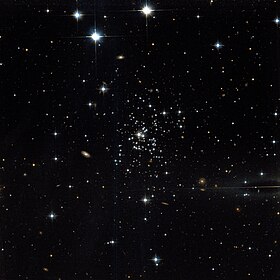Palomar 1
| Palomar 1 | |
|---|---|
 Palomar 1 by Hubble Space Telescope; 3.3′ view | |
| Observation data (J2000 epoch) | |
| Class | XII |
| Constellation | Cepheus |
| Right ascension | 03h 33m 20.04s[1] |
| Declination | +79° 34′ 51.8″[1] |
| Distance | 36.5 ± 4.2 kly (11,200 ± 1,300 pc)[2] |
| Apparent magnitude (V) | +13.18 |
| Apparent dimensions (V) | 2.8′ |
| Physical characteristics | |
| Radius | 15 ly[3] |
| Estimated age | 6.3 to 8 Gyr[2] |
| Notable features | – |
| Other designations | LEDA 13165[4] |
Palomar 1 is a globular cluster part of the Palomar group in the constellation Cepheus in the halo possibly in the Outer Arm of the Milky Way galaxy. First discovered by George O. Abell in 1954 on the Palomar Survey Sky plates,[5] it was catalogued as a globular cluster. At 6.3 to 8 Gyr, it is a very young cluster when compared to the other globular clusters in the Milky Way.[2] It is a relatively metal-poor globular with [Fe/H] = −0.60.[6] It is likely that Palomar 1 has a similar evolutionary history to the Sagittarius dwarf companion globular Terzan 7, that is, it may have once been associated with a dwarf spheroidal galaxy that was later destroyed by tidal forces.[6]
References[edit]
- ^ a b Goldsbury, Ryan; et al. (December 2010), "The ACS Survey of Galactic Globular Clusters. X. New Determinations of Centers for 65 Clusters", The Astronomical Journal, 140 (6): 1830–1837, arXiv:1008.2755, Bibcode:2010AJ....140.1830G, doi:10.1088/0004-6256/140/6/1830, S2CID 119183070.
- ^ a b c Rosenberg, A.; et al. (1998), "Palomar 1 – Another young Galactic halo globular cluster", Astronomical Journal, 115 (2): 648, arXiv:astro-ph/9710242, Bibcode:1998AJ....115..648R, doi:10.1086/300200, S2CID 119058058.
- ^ distance × sin( diameter_angle / 2 ) = 15 ly. radius
- ^ "SIMBAD Astronomical Object Database", Results for Palomar 1, retrieved 2006-11-17.
- ^ Abell, George O. (1955). "Globular Clusters and Planetary Nebulae Discovered on the National Geographic Society-Palomar Observatory Sky Survey". Publications of the Astronomical Society of the Pacific. 67 (397): 258. Bibcode:1955PASP...67..258A. doi:10.1086/126815.
- ^ a b van den Bergh, Sidney; Mackey, A. D. (2004). "Globular clusters and the formation of the outer Galactic halo". Monthly Notices of the Royal Astronomical Society. 354 (3): 713–719. arXiv:astro-ph/0407346. Bibcode:2004MNRAS.354..713V. doi:10.1111/j.1365-2966.2004.08228.x. S2CID 15407602.
External links[edit]
 Media related to Palomar 1 at Wikimedia Commons
Media related to Palomar 1 at Wikimedia Commons- SEDS: Palomar 1
- Palomar 1 on WikiSky: DSS2, SDSS, GALEX, IRAS, Hydrogen α, X-Ray, Astrophoto, Sky Map, Articles and images
